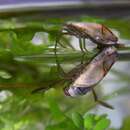Biology
provided by Arkive
The water boatman is a highly effective predator; it tends to stay motionless at the surface until it detects movements in the water, it then swims towards the source of the movement, and hunts by sight when it is close to its prey. This bug has toxic saliva and can inflict a very painful bite. A wide range of aquatic prey is taken, and they can tackle items as large as tadpoles and small fish (3).
Although mating may take place from December to late May, females typically lay their eggs between early February and early May. The eggs are embedded in plant stems. Bugs undergo a type of development known as incomplete metamorphosis in which the larvae undergo a series of moults. The stages between moults are known as 'instars'; there are 5 instars in this species, and it takes 2 months for water boatman larvae to become adults (3).
Conservation
provided by Arkive
Conservation action has not been targeted at this species.
Description
provided by Arkive
The water boatman is a common water bug, which swims on its back and is often seen at the surface of the water (3). It is light brown in colour with a number of dark markings and large reddish eyes (2). The powerful oar-like hind legs are modified for swimming; they are long, flattened and fringed with hairs (3). The forelegs, which are short and strong, are used for grabbing prey (2). The larvae, or 'nymphs', are white or greenish in colour and are fairly similar in appearance to the adults (2). The water boatman often looks silvery as air becomes trapped in a layer of bristles covering the lower surface (4). All true bugs have sucking mouthparts known as a rostrum or a beak; in this species the rostrum is very short and strong (3).
Habitat
provided by Arkive
Found in still and flowing waters with aquatic plants (1), including ponds, lakes and rivers (2).
Range
provided by Arkive
Widely distributed and common throughout Britain (1).
Status
provided by Arkive
Widespread and often common (3).
Threats
provided by Arkive
Not threatened at present.

